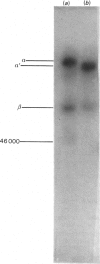Abstract
It is known that a population of B-lymphocytes has receptors for the third component of complement, C3, and that these lymphocytes may be identified by their ability to form rosettes with sheep erythrocytes coated with covalently bound fragments of complement component C3. Human tonsil lymphocytes, enriched for B-cells, form rosettes with sheep erythrocytes coated with antibody and complement components C1, C4b and C3b (EAC143b cells). Fluid-phase C3 will inhibit rosette formation between EAC143b and human tonsil lymphocytes over the same concentration range as fluid-phase C3b. C3 is not cleaved to C3b during incubation with lymphocytes or with lymphocytes and EAC143b cells. Fluid-phase 125I-labelled C3 and 125I-labelled C3b bind to lymphocytes in a specific manner. The characteristics of binding of both radioiodinated C3 and radioiodinated C3b are very similar, but the binding oc C3 is again not a result of cleavage to C3b. Salicylhydroxamic acid does not inhibit binding of 125I-labelled C3 to tonsil lymphocytes at concentrations that completely inhibit binding of 125I-labelled C3 to EAC142 cells via the nascent binding site of C3b. It is concluded that C3 and C3b share a common feature involved in binding to lymphocytes bearing receptors for the third component of complement.
Full text
PDF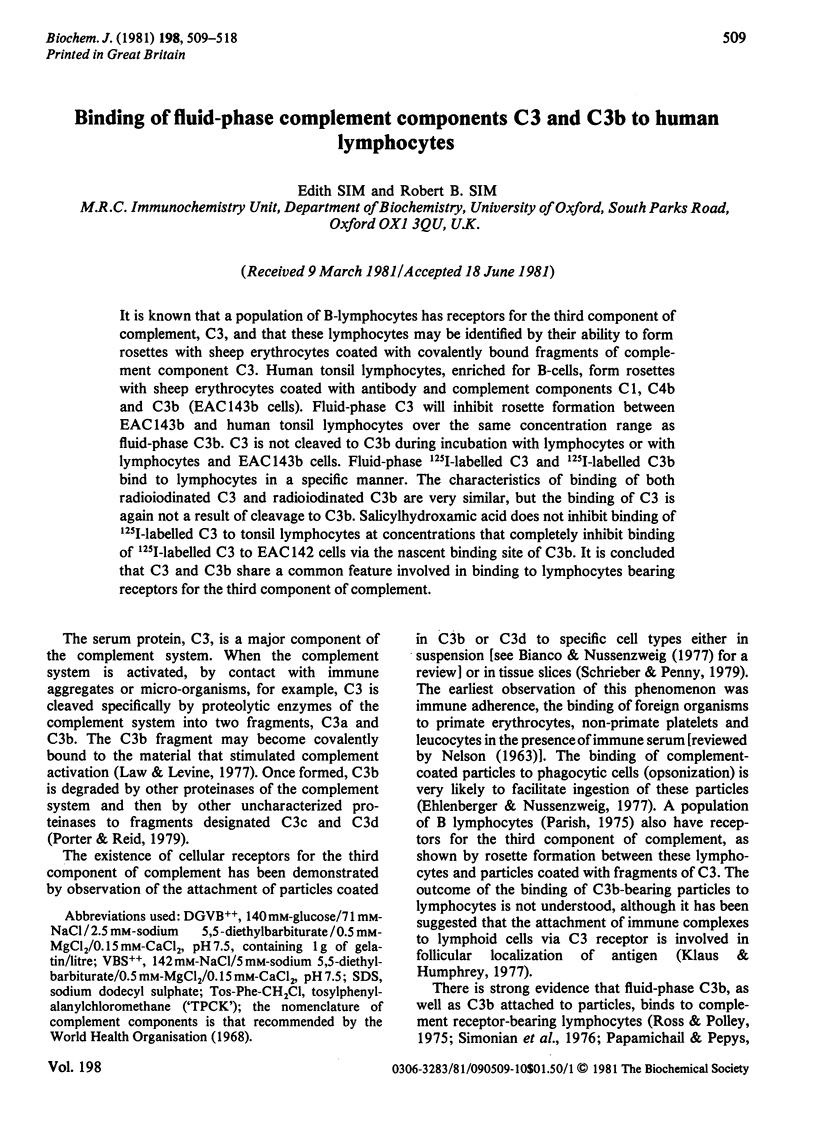
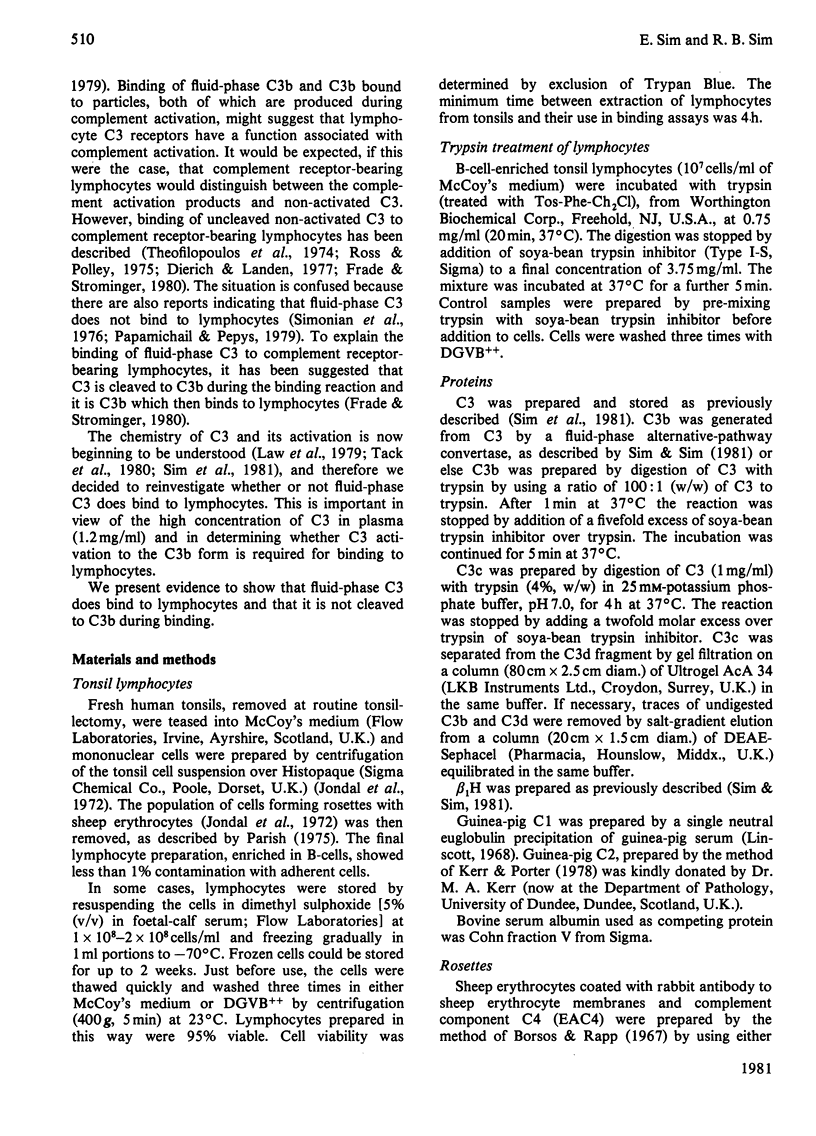
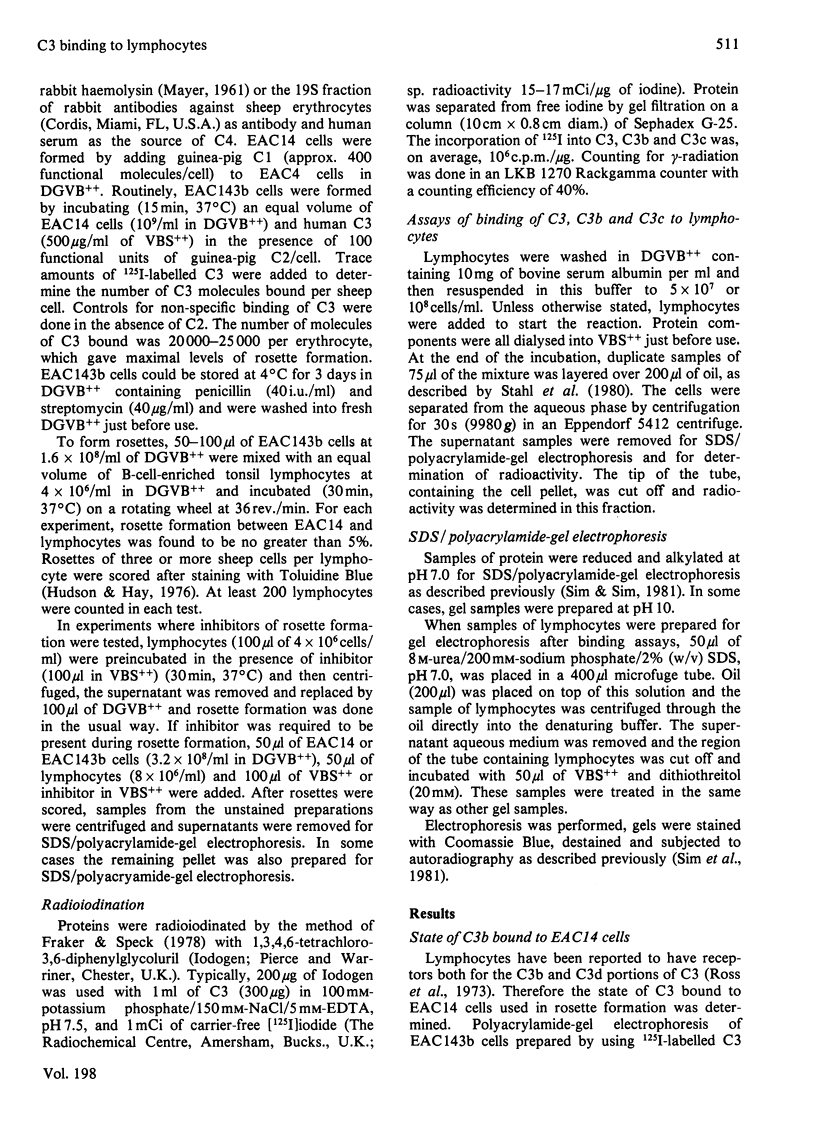
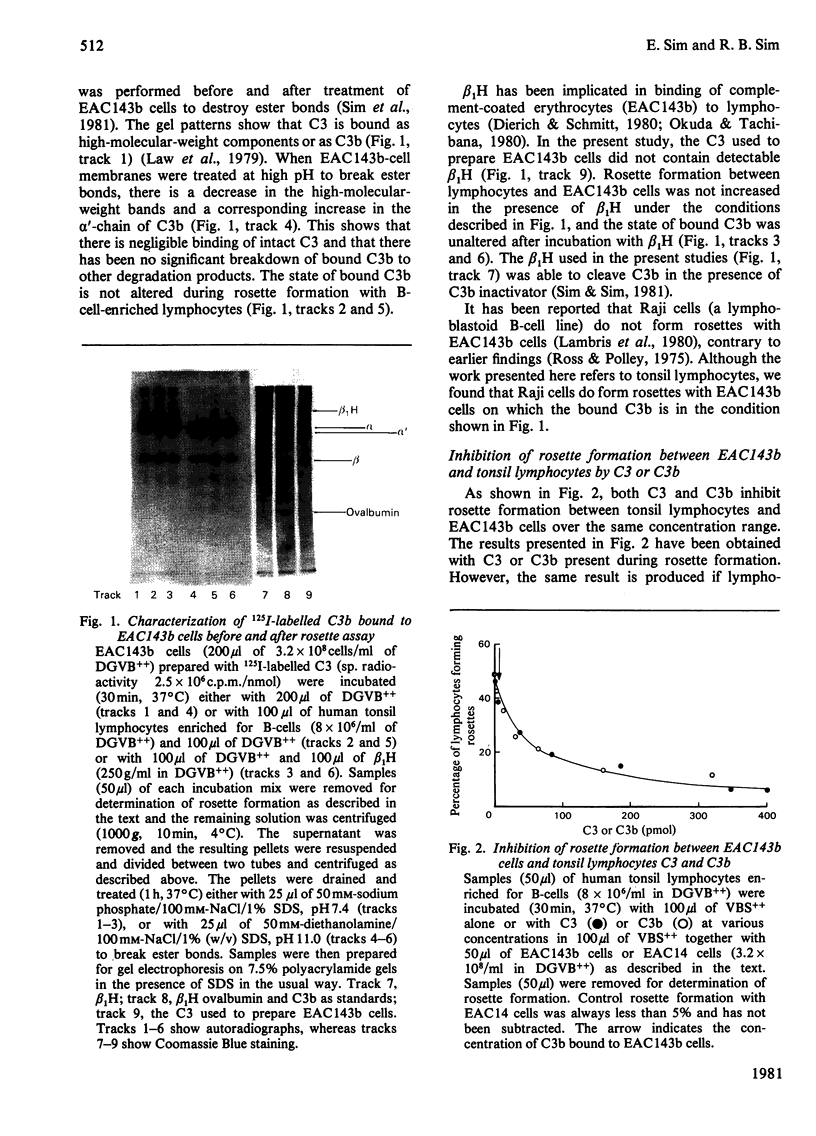
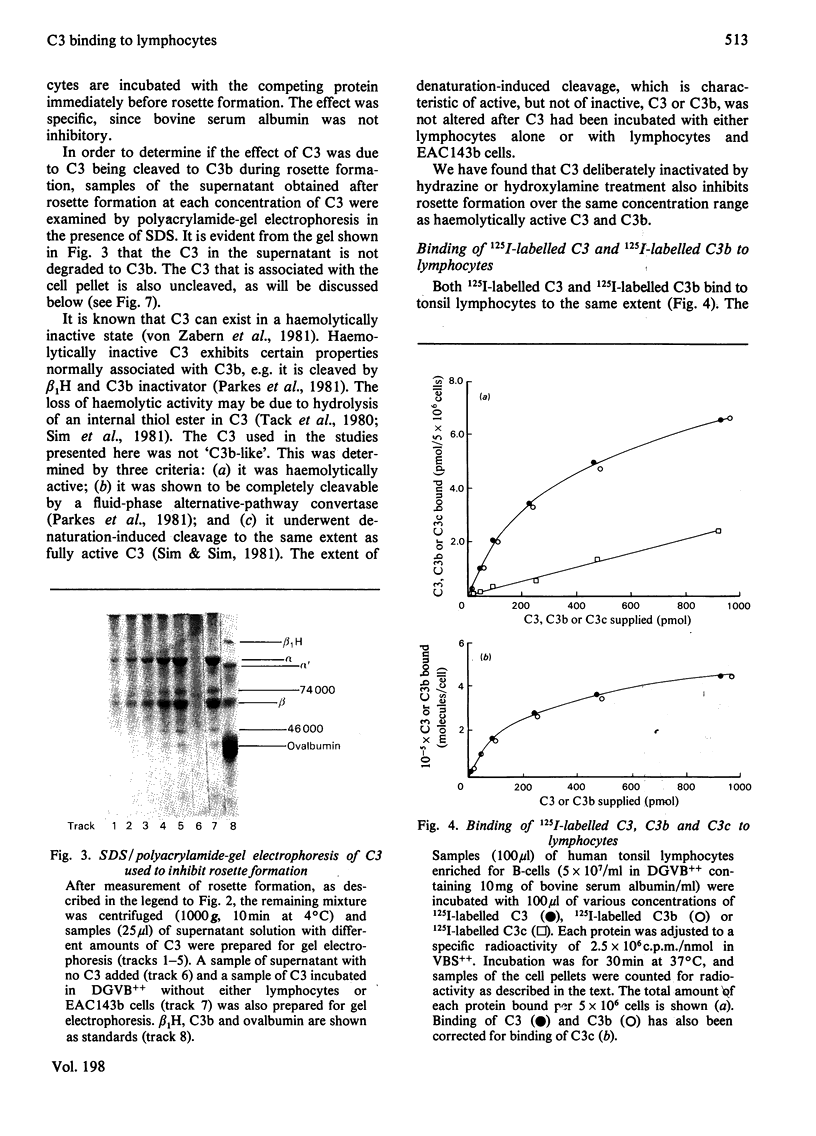
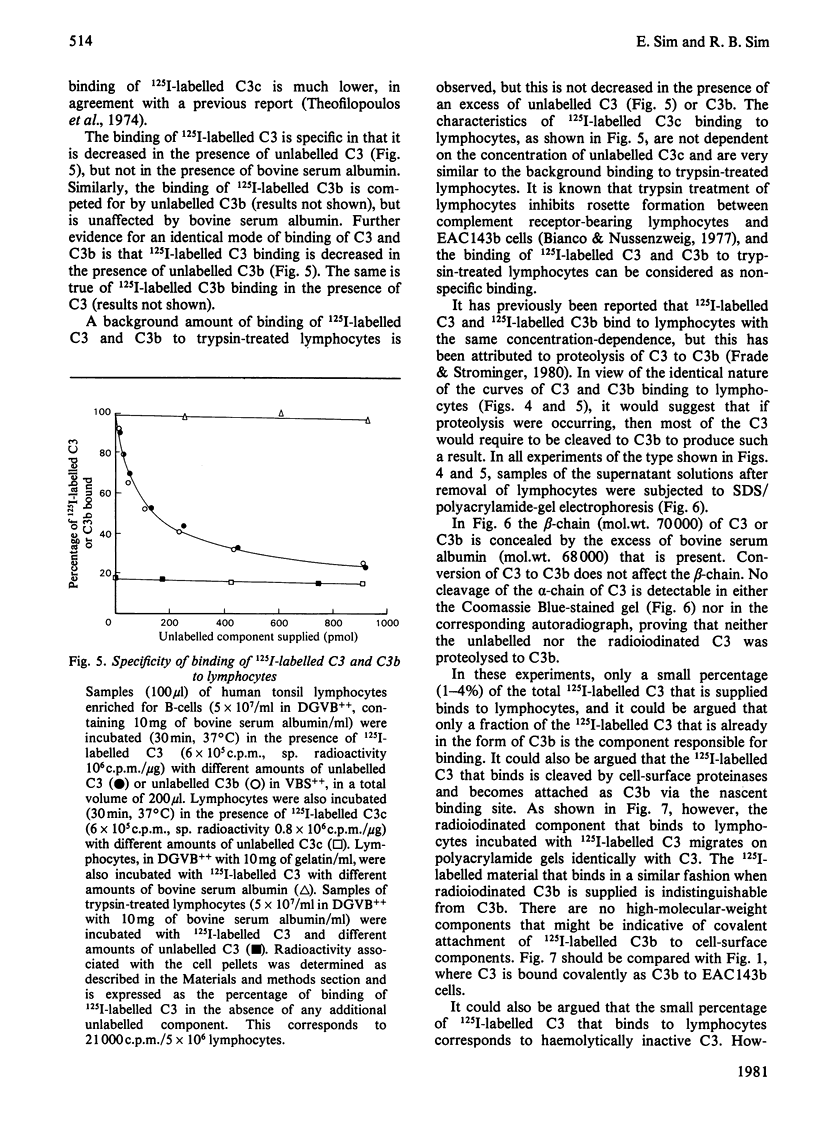
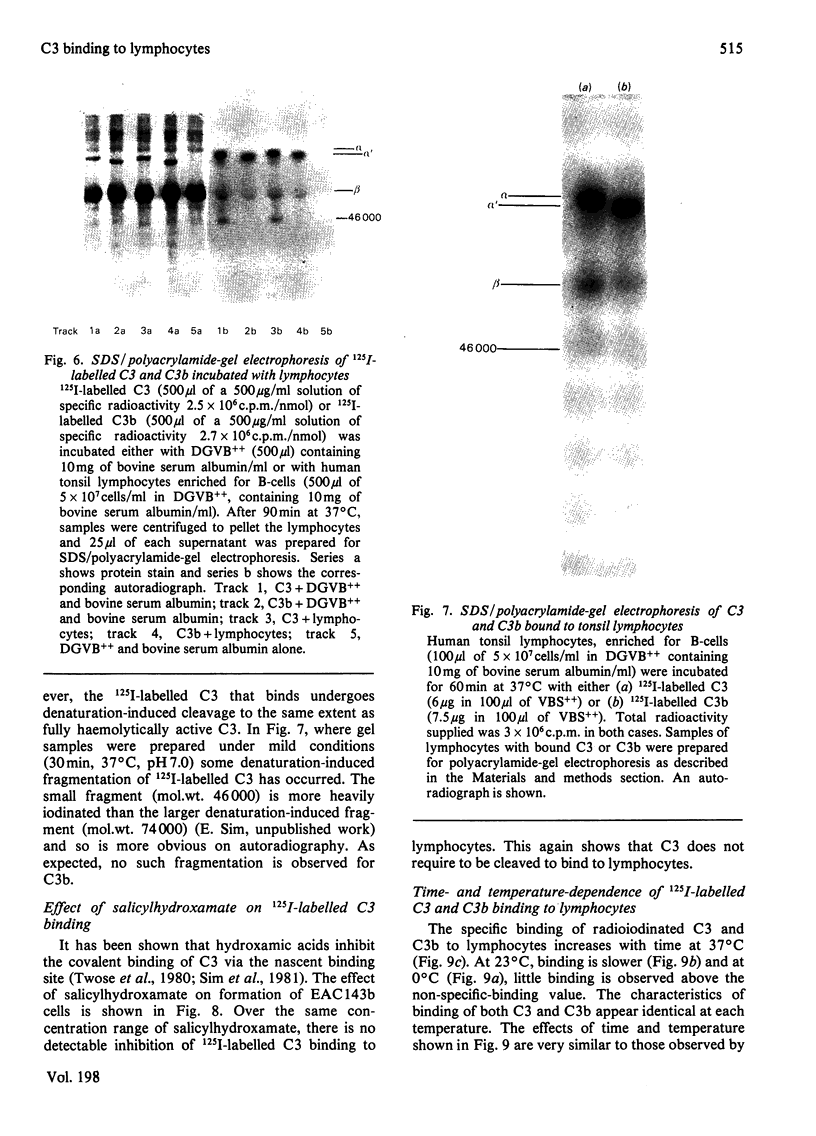
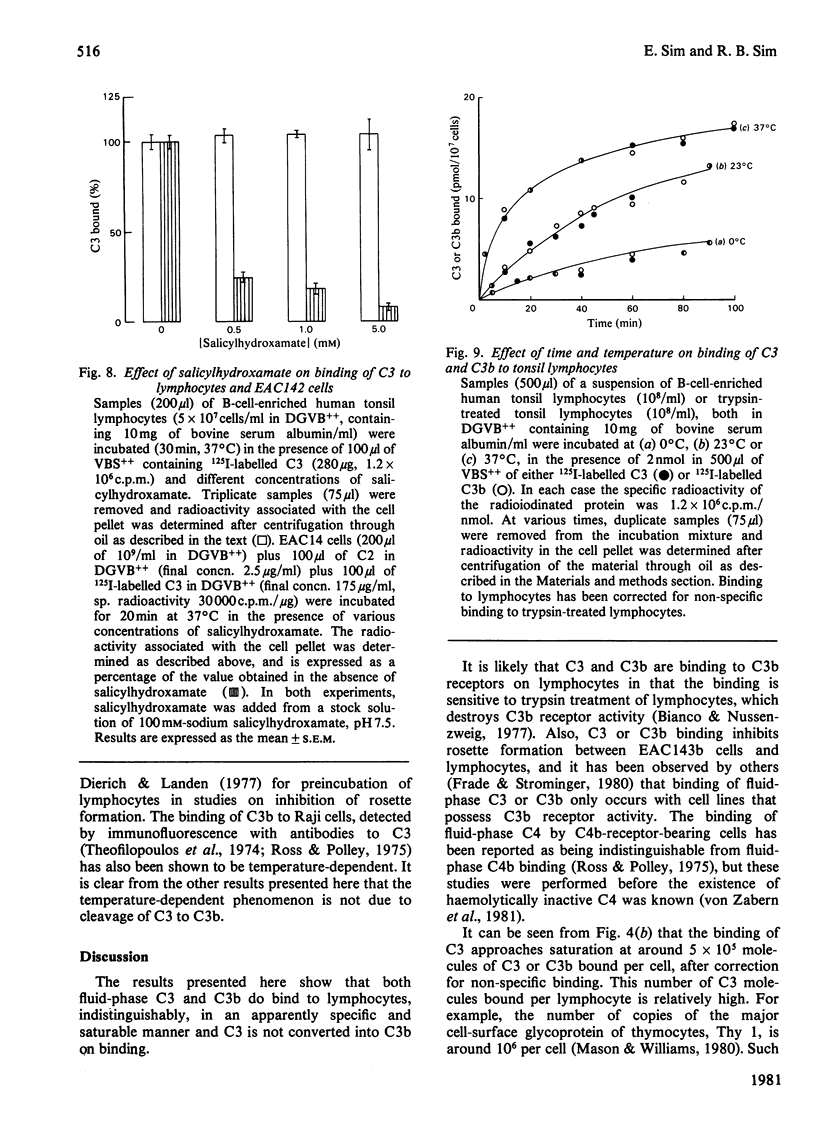
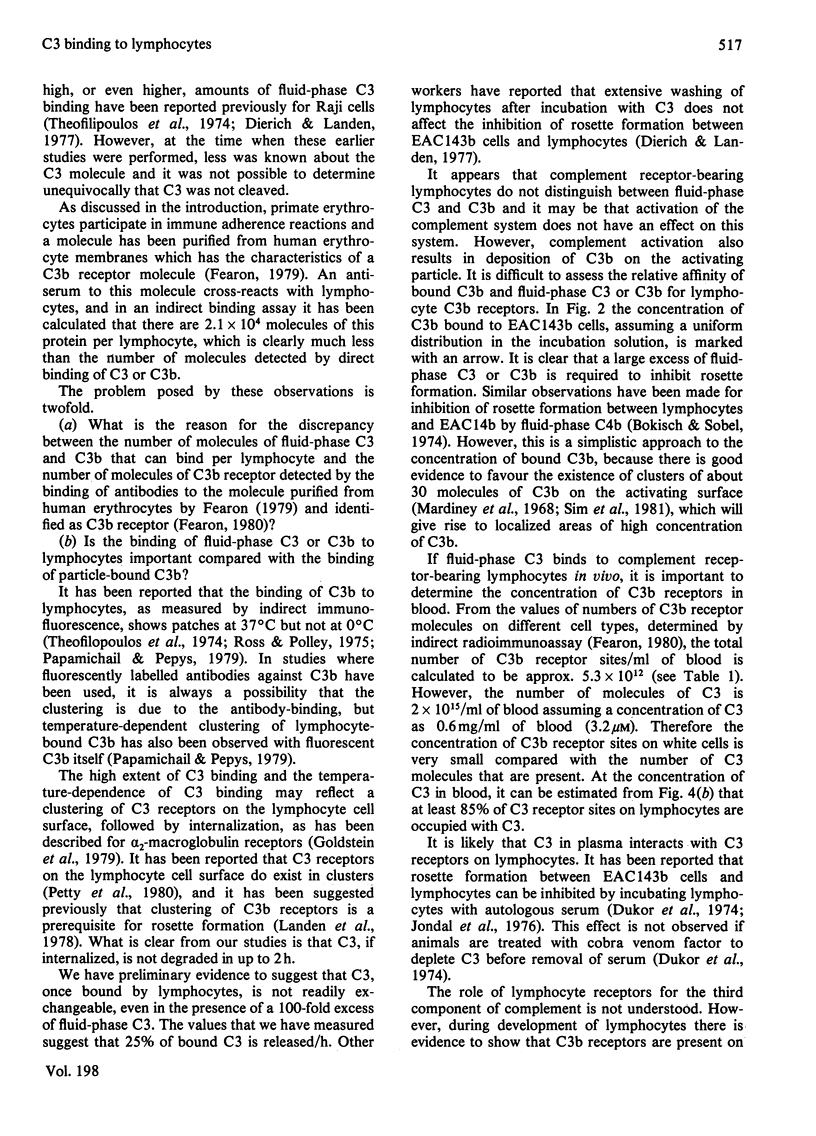
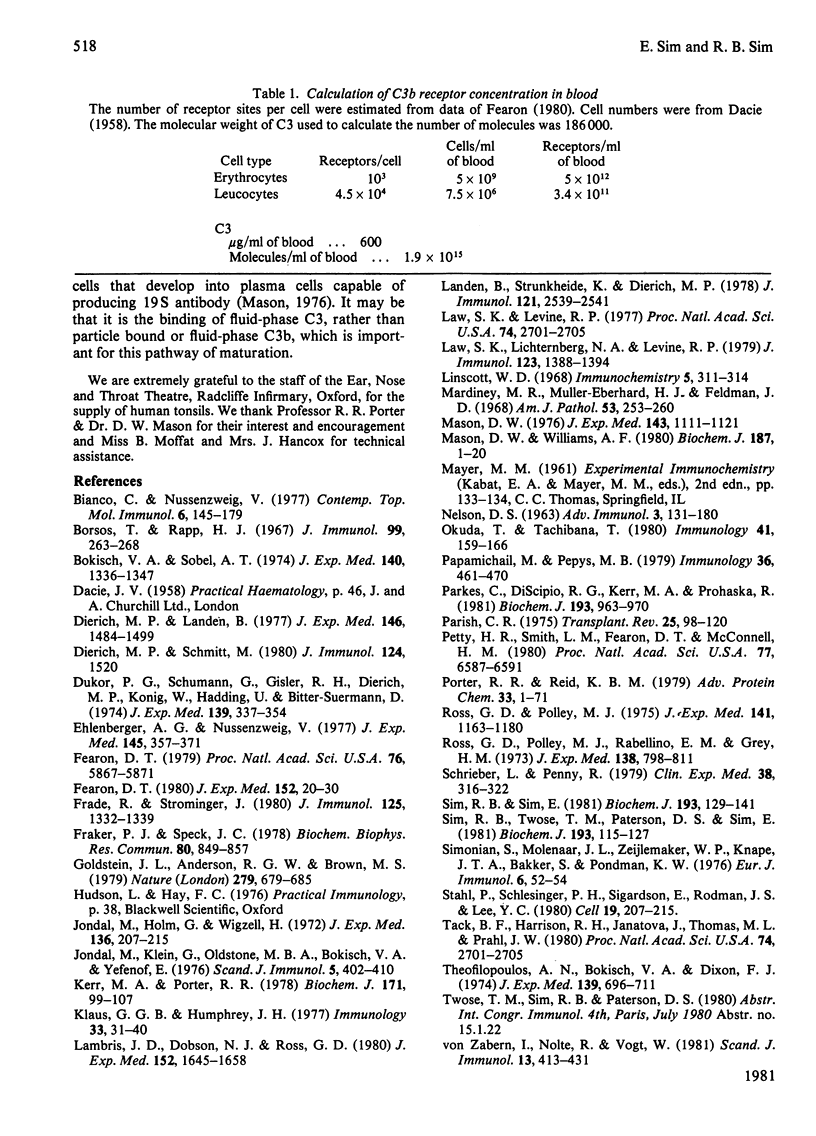
Images in this article
Selected References
These references are in PubMed. This may not be the complete list of references from this article.
- Bianco C., Nussenzweig V. Complement receptors. Contemp Top Mol Immunol. 1977;6:145–176. doi: 10.1007/978-1-4684-2841-4_5. [DOI] [PubMed] [Google Scholar]
- Bokisch V. A., Sobel A. T. Receptor for the fourth component of complement on human B lymphocytes and cultured human lymphoblastoid cells. J Exp Med. 1974 Nov 1;140(5):1336–1347. doi: 10.1084/jem.140.5.1336. [DOI] [PMC free article] [PubMed] [Google Scholar]
- Borsos T., Rapp H. J. Immune hemolysis: a simplified method for the preparation of EAC'4 with guinea pig or with human complement. J Immunol. 1967 Aug;99(2):263–268. [PubMed] [Google Scholar]
- Dierich M. P., Landen B. Complement bridges between cells analysis of a possible cell-cell interaction mechanism. J Exp Med. 1977 Dec 1;146(6):1484–1499. doi: 10.1084/jem.146.6.1484. [DOI] [PMC free article] [PubMed] [Google Scholar]
- Dukor P., Schumann G., Gisler R. H., Dierich M., König W., Hadding U., Bitter-Suermann D. Complement-dependent B-cell activation by cobra venom factor and other mitogens? J Exp Med. 1974 Feb 1;139(2):337–354. doi: 10.1084/jem.139.2.337. [DOI] [PMC free article] [PubMed] [Google Scholar]
- Ehlenberger A. G., Nussenzweig V. The role of membrane receptors for C3b and C3d in phagocytosis. J Exp Med. 1977 Feb 1;145(2):357–371. doi: 10.1084/jem.145.2.357. [DOI] [PMC free article] [PubMed] [Google Scholar]
- Fearon D. T. Identification of the membrane glycoprotein that is the C3b receptor of the human erythrocyte, polymorphonuclear leukocyte, B lymphocyte, and monocyte. J Exp Med. 1980 Jul 1;152(1):20–30. doi: 10.1084/jem.152.1.20. [DOI] [PMC free article] [PubMed] [Google Scholar]
- Fearon D. T. Regulation of the amplification C3 convertase of human complement by an inhibitory protein isolated from human erythrocyte membrane. Proc Natl Acad Sci U S A. 1979 Nov;76(11):5867–5871. doi: 10.1073/pnas.76.11.5867. [DOI] [PMC free article] [PubMed] [Google Scholar]
- Frade R., Strominger J. Binding of soluble 125I-human C3b, the third component of complement, to specific receptors in human cultured B lymphoblastoids cells: characterization of a low affinity interaction. J Immunol. 1980 Sep;125(3):1332–1339. [PubMed] [Google Scholar]
- Fraker P. J., Speck J. C., Jr Protein and cell membrane iodinations with a sparingly soluble chloroamide, 1,3,4,6-tetrachloro-3a,6a-diphrenylglycoluril. Biochem Biophys Res Commun. 1978 Feb 28;80(4):849–857. doi: 10.1016/0006-291x(78)91322-0. [DOI] [PubMed] [Google Scholar]
- Goldstein J. L., Anderson R. G., Brown M. S. Coated pits, coated vesicles, and receptor-mediated endocytosis. Nature. 1979 Jun 21;279(5715):679–685. doi: 10.1038/279679a0. [DOI] [PubMed] [Google Scholar]
- Izui S., Kelley V. E., McConahey P. J., Dixon F. J. Selective suppression of retroviral gp70-anti-gp70 immune complex formation by prostaglandin E1 in murine systemic lupus erythematosus. J Exp Med. 1980 Dec 1;152(6):1645–1658. doi: 10.1084/jem.152.6.1645. [DOI] [PMC free article] [PubMed] [Google Scholar]
- Jondal M., Holm G., Wigzell H. Surface markers on human T and B lymphocytes. I. A large population of lymphocytes forming nonimmune rosettes with sheep red blood cells. J Exp Med. 1972 Aug 1;136(2):207–215. doi: 10.1084/jem.136.2.207. [DOI] [PMC free article] [PubMed] [Google Scholar]
- Jondal M., Klein G., Oldstone M. B., Bokish V., Yefenof E. Surface markers on human B and T lymphocytes. VIII. Association between complement and Epstein-Barr virus receptors on human lymphoid cells. Scand J Immunol. 1976;5(4):401–410. doi: 10.1111/j.1365-3083.1976.tb00294.x. [DOI] [PubMed] [Google Scholar]
- Kerr M. A., Porter R. R. The purification and properties of the second component of human complement. Biochem J. 1978 Apr 1;171(1):99–107. doi: 10.1042/bj1710099. [DOI] [PMC free article] [PubMed] [Google Scholar]
- Klaus G. G., Humphrey J. H. The generation of memory cells. I. The role of C3 in the generation of B memory cells. Immunology. 1977 Jul;33(1):31–40. [PMC free article] [PubMed] [Google Scholar]
- Landen B., Strunkheide K., Dierich M. P. C3-mediated cytoadherence. II. Dependence of cell attachment on similar topographic distribution of the receptors (for C3) and the ligands (C3/C3b). J Immunol. 1978 Dec;121(6):2539–2541. [PubMed] [Google Scholar]
- Law S. K., Levine R. P. Interaction between the third complement protein and cell surface macromolecules. Proc Natl Acad Sci U S A. 1977 Jul;74(7):2701–2705. doi: 10.1073/pnas.74.7.2701. [DOI] [PMC free article] [PubMed] [Google Scholar]
- Law S. K., Lichtenberg N. A., Levine R. P. Evidence for an ester linkage between the labile binding site of C3b and receptive surfaces. J Immunol. 1979 Sep;123(3):1388–1394. [PubMed] [Google Scholar]
- Linscott W. D. Complement: purification of the first component from rabbit and guinea pig serum. Immunochemistry. 1968 May;5(3):311–314. doi: 10.1016/0019-2791(68)90075-x. [DOI] [PubMed] [Google Scholar]
- Mardiney M. R., Jr, Müller-Eberhard H. J., Feldman J. D. Ultrastructural localization of the third and fourth components of complement on complement-cell complexes. Am J Pathol. 1968 Aug;53(2):253–261. [PMC free article] [PubMed] [Google Scholar]
- Mason D. W. The requirement for C3 receptors on the precursors of 19S and 7S antibody-forming cells. J Exp Med. 1976 May 1;143(5):1111–1121. doi: 10.1084/jem.143.5.1111. [DOI] [PMC free article] [PubMed] [Google Scholar]
- Mason D. W., Williams A. F. The kinetics of antibody binding to membrane antigens in solution and at the cell surface. Biochem J. 1980 Apr 1;187(1):1–20. doi: 10.1042/bj1870001. [DOI] [PMC free article] [PubMed] [Google Scholar]
- Okuda T., Tachibana T. Complement receptors on Raji cells. The presence of a new type of C3 receptor. Immunology. 1980 Sep;41(1):159–166. [PMC free article] [PubMed] [Google Scholar]
- Papamichail M., Pepys M. B. Lymphocyte binding of fluid phase mouse C3b. Immunology. 1979 Mar;36(3):461–470. [PMC free article] [PubMed] [Google Scholar]
- Parish C. R. Separation and functional analysis of subpopulations of lymphocytes bearing complement and Fc receptors. Transplant Rev. 1975;25:98–120. doi: 10.1111/j.1600-065x.1975.tb00727.x. [DOI] [PubMed] [Google Scholar]
- Parkes C., DiScipio R. G., Kerr M. A., Prohaska R. The separation of functionally distinct forms of the third component of human complement (C3). Biochem J. 1981 Mar 1;193(3):963–970. doi: 10.1042/bj1930963. [DOI] [PMC free article] [PubMed] [Google Scholar]
- Petty H. R., Smith L. M., Fearon D. T., McConnell H. M. Lateral distribution and diffusion of the C3b receptor of complement, HLA antigens, and lipid probes in peripheral blood leukocytes. Proc Natl Acad Sci U S A. 1980 Nov;77(11):6587–6591. doi: 10.1073/pnas.77.11.6587. [DOI] [PMC free article] [PubMed] [Google Scholar]
- Porter R. R., Reid K. B. Activation of the complement system by antibody-antigen complexes: the classical pathway. Adv Protein Chem. 1979;33:1–71. doi: 10.1016/s0065-3233(08)60458-1. [DOI] [PubMed] [Google Scholar]
- Ross G. D., Polley M. J., Rabellino E. M., Grey H. M. Two different complement receptors on human lymphocytes. One specific for C3b and one specific for C3b inactivator-cleaved C3b. J Exp Med. 1973 Oct 1;138(4):798–811. doi: 10.1084/jem.138.4.798. [DOI] [PMC free article] [PubMed] [Google Scholar]
- Ross G. D., Polley M. J. Specificity of human lymphocyte complement receptors. J Exp Med. 1975 May 1;141(5):1163–1180. doi: 10.1084/jem.141.5.1163. [DOI] [PMC free article] [PubMed] [Google Scholar]
- Schrieber L., Penny R. Tissue C3b receptors. Clin Exp Immunol. 1979 Nov;38(2):316–322. [PMC free article] [PubMed] [Google Scholar]
- Sim R. B., Twose T. M., Paterson D. S., Sim E. The covalent-binding reaction of complement component C3. Biochem J. 1981 Jan 1;193(1):115–127. doi: 10.1042/bj1930115. [DOI] [PMC free article] [PubMed] [Google Scholar]
- Simonian S., Molenaar J. L., Zeijlemaker W. P., Knape J. T., Bakker S., Pondman K. W. Interaction of human lymphocytes with fluid phase human C3b detected by immunofluorescence. Eur J Immunol. 1976 Jan;6(1):52–56. doi: 10.1002/eji.1830060111. [DOI] [PubMed] [Google Scholar]
- Stahl P., Schlesinger P. H., Sigardson E., Rodman J. S., Lee Y. C. Receptor-mediated pinocytosis of mannose glycoconjugates by macrophages: characterization and evidence for receptor recycling. Cell. 1980 Jan;19(1):207–215. doi: 10.1016/0092-8674(80)90402-x. [DOI] [PubMed] [Google Scholar]
- Theofilopoulos A. N., Bokisch V. A., Dixon F. J. Receptor for soluble C3 and C3b on human lymphoblastoid (RAJI) cells. Properties and biologocal significance. J Exp Med. 1974 Mar 1;139(3):696–711. doi: 10.1084/jem.139.3.696. [DOI] [PMC free article] [PubMed] [Google Scholar]
- von Zabern I., Nolte R., Vogt W. Treatment of human complement components C4 and C3 with amines or chaotropic ions. Evidence of a functional and structural change that provides uncleaved C4 and C3 with properties of their soluble activated froms, C4b and C3b. Scand J Immunol. 1981;13(5):413–431. doi: 10.1111/j.1365-3083.1981.tb00152.x. [DOI] [PubMed] [Google Scholar]






